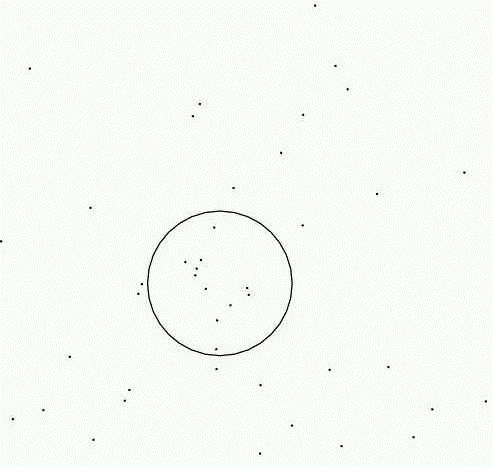这道题是一道计算几何入门题,题意很直白,主要是要算圆心。我这里用了一个O(n^3)的方法,勉强能过。
大体思路:枚举两个点,以此来构建一个圆,找出一个圆心(如果有两个圆心的话,不必算两个圆心),然后再枚举每个点,计算是否在圆内,最终算出圆内最多包含的点数。
需要注意的地方:第一,要注意答案至少是1,所以下面代码中的sum初始化要为1;第二,枚举两个点时,要排除两点之间距离大于直径的情况,否则TLE;第三,求圆心时要考虑好组成弦的两个点X和Y的大小关系对角度正负的影响,以及利用好这种影响,主要是atan2函数;第四,就是只要一个圆心就好,不需要两个(至于为什么只要一个就可以,可能我很难给出严格的证明,但是想一想,还是能理解的)。
补充:hdu 1077与此题意思一样,所以大家还可以做做那里的。至于更高效的算法,可以参考这位大神的博客:POJ 1981 Circle and Points(单位圆覆盖n^3&&n^2lgn)
代码(C++):
#include <cstdlib>
#include <iostream>
#include <cmath>
#define MAX 309
#define EPS 1e-8
using namespace std;
//#define LOCAL
struct Point{
double x;
double y;
};
Point point[MAX];
inline double dist(Point a,Point b)
{
return sqrt((a.x-b.x)*(a.x-b.x)+(a.y-b.y)*(a.y-b.y));
}
inline void getCenterPoint(Point a,Point b,Point &c1)
{
double corner,d;
Point mid;
mid.x=(a.x+b.x)/2.0;
mid.y=(a.y+b.y)/2.0;
d=dist(a,mid);
d=sqrt(1-d*d);
corner=-atan2(a.x-b.x,a.y-b.y);//atan(abs((a.x-b.x)/(a.y-b.y)));
c1.x=mid.x+d*cos(corner);
c1.y=mid.y+d*sin(corner);
//c2.x=mid.x-d*cos(corner);
//c2.y=mid.y-d*sin(corner);
}
int main(int argc, char *argv[])
{
#ifdef LOCAL
freopen("in.txt","r",stdin);
freopen("out.txt","w",stdout);
#endif
int n,i,j,k,sum,sum1;
Point c1;
while(scanf("%d",&n)&&n!=0)
{
for(i=0;i<n;i++) scanf("%lf %lf",&point[i].x,&point[i].y);
sum=1;
for(i=0;i<n;i++)
{
for(j=i+1;j<n;j++)
{
if(dist(point[i],point[j])>2+EPS) continue;
getCenterPoint(point[i],point[j],c1);
sum1=0;
for(k=0;k<n;k++)
{
if(dist(c1,point[k])<1+EPS) sum1++;
// if(dist(c2,point[k])<1+EPS) sum2++;
}
//sum1=sum1>sum2?sum1:sum2;
sum=sum1>sum?sum1:sum;
}
}
printf("%d\n",sum);
}
system("PAUSE");
return EXIT_SUCCESS;
}
Circle and Points
| Time Limit: 5000MS | Memory Limit: 30000K | |
| Case Time Limit: 2000MS | ||
Description
You are given N points in the xy-plane. You have a circle of radius one and move it on the xy-plane, so as to enclose as many of the points as possible. Find how many points can be simultaneously enclosed at the maximum. A point is considered enclosed by a circle when it is inside or on the circle.

Fig 1. Circle and Points

Fig 1. Circle and Points
Input
The input consists of a series of data sets, followed by a single line only containing a single character '0', which indicates the end of the input. Each data set begins with a line containing an integer N, which indicates the number of points in the data set. It is followed by N lines describing the coordinates of the points. Each of the N lines has two decimal fractions X and Y, describing the x- and y-coordinates of a point, respectively. They are given with five digits after the decimal point.
You may assume 1 <= N <= 300, 0.0 <= X <= 10.0, and 0.0 <= Y <= 10.0. No two points are closer than 0.0001. No two points in a data set are approximately at a distance of 2.0. More precisely, for any two points in a data set, the distance d between the two never satisfies 1.9999 <= d <= 2.0001. Finally, no three points in a data set are simultaneously very close to a single circle of radius one. More precisely, let P1, P2, and P3 be any three points in a data set, and d1, d2, and d3 the distances from an arbitrarily selected point in the xy-plane to each of them respectively. Then it never simultaneously holds that 0.9999 <= di <= 1.0001 (i = 1, 2, 3).
You may assume 1 <= N <= 300, 0.0 <= X <= 10.0, and 0.0 <= Y <= 10.0. No two points are closer than 0.0001. No two points in a data set are approximately at a distance of 2.0. More precisely, for any two points in a data set, the distance d between the two never satisfies 1.9999 <= d <= 2.0001. Finally, no three points in a data set are simultaneously very close to a single circle of radius one. More precisely, let P1, P2, and P3 be any three points in a data set, and d1, d2, and d3 the distances from an arbitrarily selected point in the xy-plane to each of them respectively. Then it never simultaneously holds that 0.9999 <= di <= 1.0001 (i = 1, 2, 3).
Output
For each data set, print a single line containing the maximum number of points in the data set that can be simultaneously enclosed by a circle of radius one. No other characters including leading and trailing spaces should be printed.
Sample Input
3 6.47634 7.69628 5.16828 4.79915 6.69533 6.20378 6 7.15296 4.08328 6.50827 2.69466 5.91219 3.86661 5.29853 4.16097 6.10838 3.46039 6.34060 2.41599 8 7.90650 4.01746 4.10998 4.18354 4.67289 4.01887 6.33885 4.28388 4.98106 3.82728 5.12379 5.16473 7.84664 4.67693 4.02776 3.87990 20 6.65128 5.47490 6.42743 6.26189 6.35864 4.61611 6.59020 4.54228 4.43967 5.70059 4.38226 5.70536 5.50755 6.18163 7.41971 6.13668 6.71936 3.04496 5.61832 4.23857 5.99424 4.29328 5.60961 4.32998 6.82242 5.79683 5.44693 3.82724 6.70906 3.65736 7.89087 5.68000 6.23300 4.59530 5.92401 4.92329 6.24168 3.81389 6.22671 3.62210 0
Sample Output
2 5 5 11


























 538
538

 被折叠的 条评论
为什么被折叠?
被折叠的 条评论
为什么被折叠?








